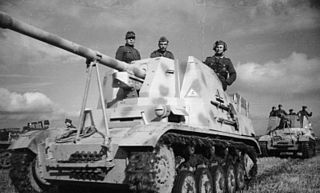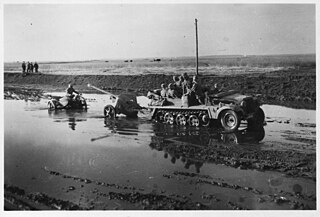
The Leichter Panzerspähwagen was a series of light four-wheel drive armoured cars produced by Nazi Germany from 1935 to 1944.

A half-track is a civilian or military vehicle with regular wheels at the front for steering and continuous tracks at the back to propel the vehicle and carry most of the load. The purpose of this combination is to produce a vehicle with the cross-country capabilities of a tank and the handling of a wheeled vehicle.

The Sd.Kfz. 251 half-track was a World War II German armored personnel carrier designed by the Hanomag company, based on its earlier, unarmored Sd.Kfz. 11 vehicle. The Sd.Kfz. 251 was designed to transport the Panzergrenadier into battle. Sd.Kfz. 251s were the most widely produced German half-tracks of the war, with at least 15,252 vehicles and variants produced by seven manufacturers. The utility of this vehicle lead the German Army to develop the similar looking but shorter and lighter Sd.Kfz. 250 as a supplement.

The Marder II was a German tank destroyer of World War II based on the Panzer II chassis. There were two versions, the first mounted a modified Soviet 7.62 cm gun firing German ammunition, while the other mounted the German 7.5 cm Pak 40 gun. Its high profile and thin open-topped armor provided minimal protection to the crew. Nevertheless, the Marder II provided a great increase in firepower over contemporary German tanks during 1942 and into 1943. Only four Marder IIs remain today.

The Sd.Kfz. 250 was a light armoured half-track, very similar in appearance to the larger Hanomag-designed Sd.Kfz. 251, and built by the DEMAG firm, for use by Nazi Germany in World War II. Most variants were open-topped and had a single access door in the rear.

The Sd.Kfz. 6 was a half-track military vehicle used by the German Wehrmacht during the Second World War. It was designed to be used as the main towing vehicle for the 10.5 cm leFH 18 howitzer.

The Sd.Kfz. 7 was a half-track military vehicle used by the German Army, Luftwaffe and Waffen-SS during the Second World War. Sd.Kfz. is an abbreviation of the German word Sonderkraftfahrzeug, "special purpose vehicle". A longer designation is mittlerer Zugkraftwagen 8t, Sd.Kfz. 7, "medium towing motor vehicle 8t".

The Goliath tracked mine was a series of two unmanned ground vehicles used by the German Army as disposable demolition vehicles during World War II. These were the electrically powered Sd.Kfz. 302 and the petrol-engine powered Sd.Kfz. 303a and 303b. They were known as "beetle tanks" by the Allies.

The 2 cm KwK 30 L/55(2 cm Kampfwagenkanone 30 L/55) was a German 2 cm cannon used as the main armament of the German Sd.Kfz.121 Panzerkampfwagen II light tank and various reconnaissance vehicles. It was used during the Spanish Civil War and the Second World War. It was produced by Mauser and Rheinmetall-Borsig from 1935.

The leichter gepanzerter Munitionstransportwagen was a light armoured ammunition carrier used by Nazi Germany during World War II as early as the Battle of France in June 1940.

The Sd.Kfz. 10 was a German half-track that saw widespread use in World War II. Its main role was as a prime mover for small towed guns, such as the 2 cm Flak 30, the 7.5 cm leIG, or the 3.7 cm Pak 36 anti-tank gun. It could carry eight troops in addition to towing a gun or trailer.

The DURO is a series of wheeled, multi-purpose military transport vehicles produced by General Dynamics European Land Systems/MOWAG in both four and six wheel drive. It was initially developed for Switzerland by Bucher-Guyer AG in Niederweningen, Switzerland. An initial 3000 vehicles order for the Swiss Armed Forces came through in 1994. In January 2003 the production was transferred to MOWAG in Kreuzlingen. Over 4,000 DURO 4x4 and 6x6 vehicles are now in service worldwide. The main customers are Switzerland, Germany, Venezuela, and the UK. In addition to these, the vehicle is used in many other countries for special purposes.
The Panzerkampfwagen I was a light tank produced in Germany in the 1930s. The Panzer I was built in several variants and was the basis for a number of variants listed below.

The Heuschrecke 10 was a German prototype self-propelled gun and Waffenträger developed by Krupp-Gruson between 1943 and 1944. The official designation of the vehicle was 105 mm leichte Feldhaubitze 18/1 L/28 auf Waffenträger Geschützwagen IVb and was to be built in Magdeburg, Germany. The Heuschrecke featured a removable turret which could be deployed as a pillbox or towed behind the vehicle as an artillery piece.

A reconnaissance vehicle, also known as a scout vehicle, is a military vehicle used for forward reconnaissance. Both tracked and wheeled reconnaissance vehicles are in service. In some nations, light tanks such as the M551 Sheridan and AMX-13 have also been used by scout platoons. Their armament ranges from a medium machine gun to a large cannon. Modern examples are often fitted with ATGMs and a wide range of sensors.
The Panzerselbstfahrlafette 1a 5 cm PaK 38 auf Gepanzerter Munitionsschlepper or Pz. Sfl. 1a was a German light tank destroyer that was developed during World War II.















